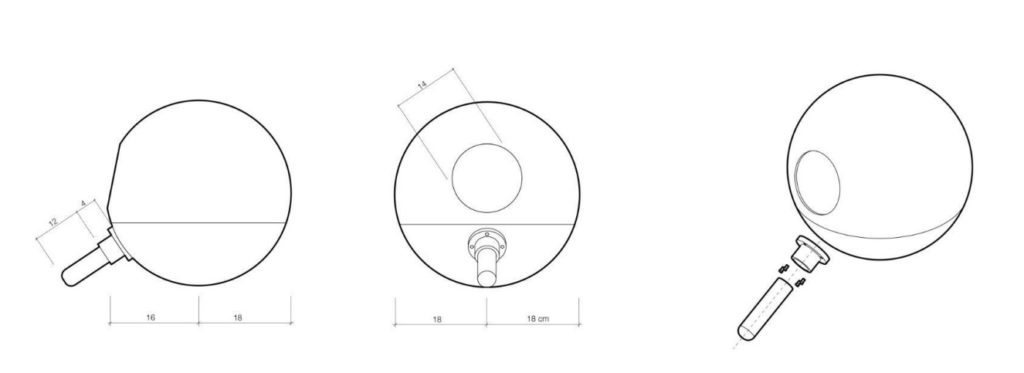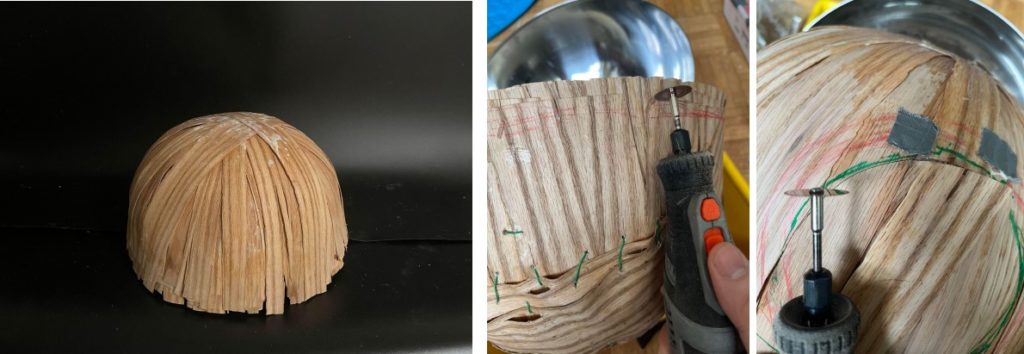
This project aims to create a durable and stylish cat cave using white oak veneer sheets, an innovative material that enhances woodworking skills and techniques. By stitching and molding the veneer sheets together, two spheres are created that are then connected to form the structure of the cat cave called “The Cat Sphere”. This project involves the use of different tools and techniques such as cutting, gluing, veneer stitching, and sanding, which are essential in developing woodworking skills, creative thinking, and problem-solving abilities. The final product can be further customized with a cushion or blanket to provide a comfortable and cozy space for cats.

As pet owners, providing our cats with a comfortable and safe place to rest and play is crucial. While traditional options such as felt cat caves and cardboard boxes have their benefits, creating a cat cave out of white oak veneer sheets offers a more stylish and long-lasting option. The problem is that the current design of the felt-cat cave is not structurally sound enough to withstand the weight and movements of the cats. The cats end
up collapsing the cat cave and using it as a perch instead of a comfortable sleeping spot (Fig above). This defeats the purpose of the cat cave, which was created to provide a durable and secure alternative to the cardboard boxes that the cats love to play with but ultimately destroy. In this project, we will explore the advantages of using white oak veneer sheets and the woodworking skills that can be developed in the process.

Materials: To create a white oak veneer cat cave, several materials and tools are needed, including white oak veneer sheets, carpenter’s glue, regular white glue, a poplar stick piece, a 3D printed connector for the poplar stick, a utility knife, cutting mat, rotary tool, sticky back
sandpaper, glue roller or paint brush, wire, veneer press, metal clips, and magnets.
Method: The technique of molding white oak veneer sheets to create a cat cave offers an opportunity to learn and practice various woodworking skills, including mold-making, cutting, arranging veneer sheets, gluing techniques, and veneer stitching. Veneer stitching is a technique that involves cutting a series of slits or “stitches” in the edges of the veneer sheets, then interlocking the stitches to form a tight, seamless joint. This technique was used to connect veneer sheets to create plywood boards and two half spheres together.
Process:







Future Work
There are several ways that you can improve this cat-cave design:
Use different materials: While white oak veneer sheets are a beautiful and unique material, you can experiment with different materials to create different textures, colors, and patterns. For example, you could use a combination of wood and fabric to create a cozy and comfortable interior.
Improve the durability: To improve the durability of the cat cave, I consider adding a protective layer of finish or coating to the surface. This will help to protect the wood and ensure that the cat cave lasts for a long time.
Better use of material and technic: Make it more versatile: I could consider making the cat cave more versatile by adding legs or wheels, making it easier to move around the house. This will allow you to change up the location of the cat cave and keep things interesting for my cats. During the making of the cat cave, there were a few issues that impacted the final result. Firstly, two spheres did not dry properly in the mold, which resulted in an uneven surface. Additionally, the metal bowl used as a mold was not the best choice as it caused the size of the cat cave to shrink and the shape to become distorted as it dried. The veneer sheets also had inconsistencies in their layout, which led to an amorphous shape. To further enhance the quality of the project, I recommend using a mold that is better suited to the desired shape and size of the cat cave. Additionally, ensuring that the veneer sheets are of uniform thickness and arranged in a more precise manner will result in a more aesthetically pleasing outcome. Experimenting with different types of glue or adhesive can also lead to a more stable and solid structure. In my next iteration, I plan to increase the size of the cat cave for greater comfort. While my adult cats showed interest in using the cave, they had difficulty maneuvering inside, making this size more suitable for young cats and kittens. To increase stability, I plan to use two legs, which can be easily attached to the
semi-spheres without the need for a 3D-printed connector. Connectors could be made of wood if needed. I still prefer the playful sphere shape for the cat cave, as I have seen my cats attempting to climb and sit on it.

In conclusion, the creation of a cat cave using white oak veneer sheets and a metal bowl as a mold is a unique and creative project that provides a comfortable and stylish space for cats to relax in. The project requires some basic woodworking skills and knowledge of tools, but it also provides an opportunity to exercise creativity and experiment with different materials and techniques. While there are some limitations to this project, such as the cost and availability of white oak veneer sheets, and the time-consuming nature of the project, it is a rewarding endeavor for those with the necessary skills and resources. Overall, this project demonstrates the importance of planning, attention to detail, patience, and safety when working with tools and equipment. The project provides a fun and challenging opportunity to create something that is both functional and aesthetically pleasing, while also exercising woodworking skills and creativity. It is a project that can be enjoyed by cat owners and woodworking enthusiasts alike.